HA3042 Taxation Law: Fringe Benefits and Capital Gains Analysis T1
VerifiedAdded on 2023/03/31
|11
|2791
|106
Homework Assignment
AI Summary
This assignment solution delves into various aspects of taxation law, focusing on fringe benefits tax (FBT) and capital gains tax (CGT). It analyzes the tax implications of providing fringe benefits, such as company cars, to employees, including calculations using both statutory formula and operating cost methods. The assignment also addresses CGT events, including the sale of property, collectables (paintings), personal assets (luxury yachts), and shares, determining whether these events result in taxable capital gains or allowable capital losses. The document is available on Desklib, a platform offering study tools and resources for students.
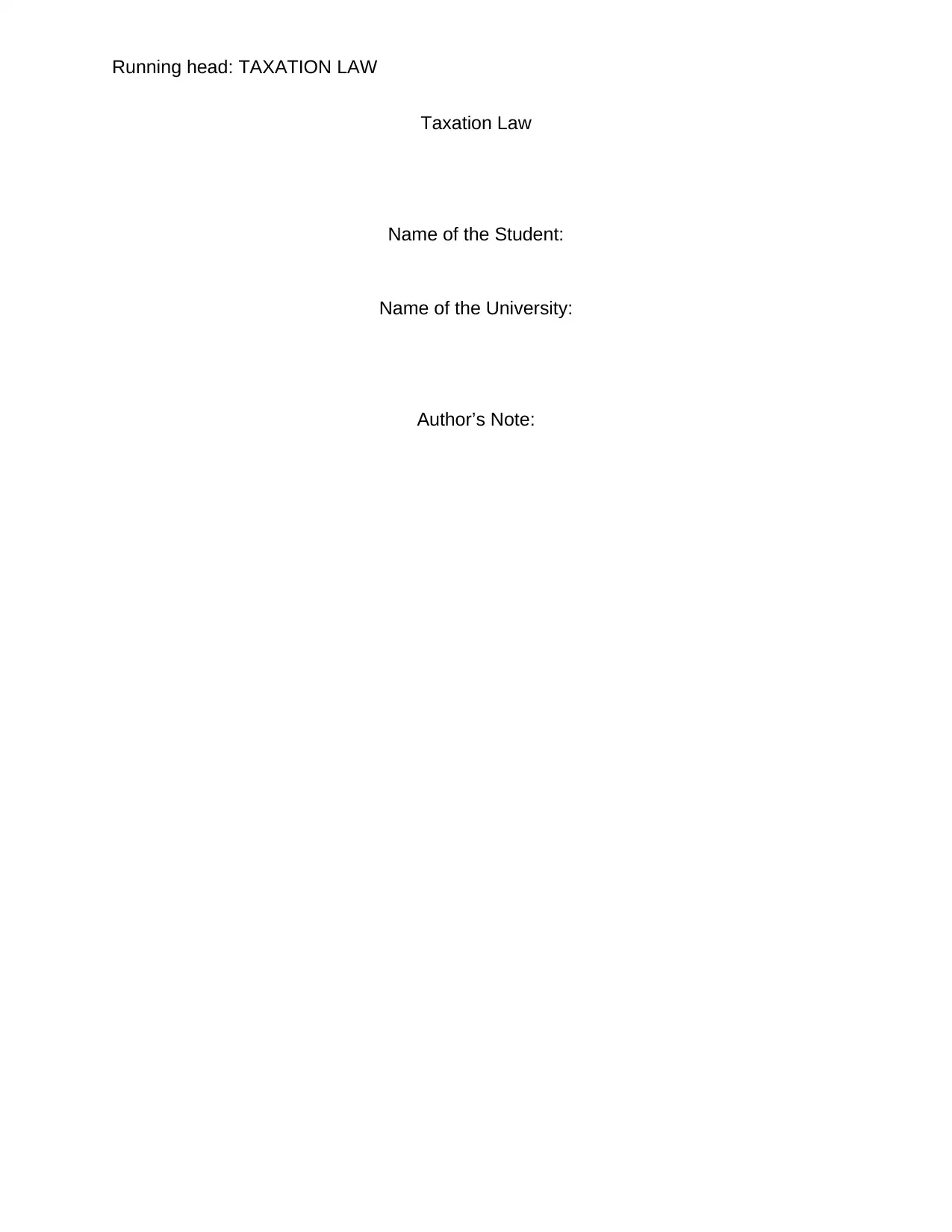
Running head: TAXATION LAW
Taxation Law
Name of the Student:
Name of the University:
Author’s Note:
Taxation Law
Name of the Student:
Name of the University:
Author’s Note:
Paraphrase This Document
Need a fresh take? Get an instant paraphrase of this document with our AI Paraphraser
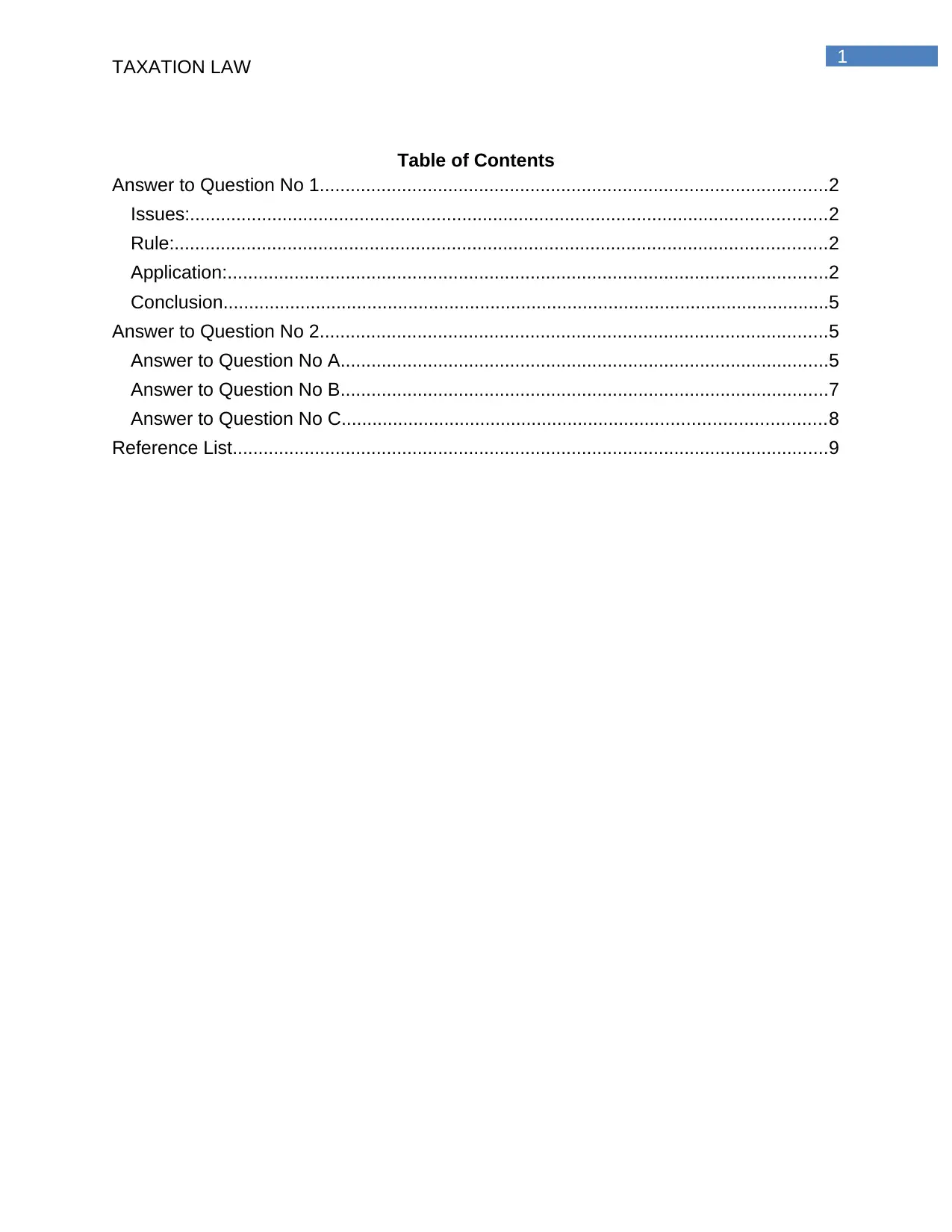
1
TAXATION LAW
Table of Contents
Answer to Question No 1...................................................................................................2
Issues:............................................................................................................................2
Rule:...............................................................................................................................2
Application:.....................................................................................................................2
Conclusion......................................................................................................................5
Answer to Question No 2...................................................................................................5
Answer to Question No A...............................................................................................5
Answer to Question No B...............................................................................................7
Answer to Question No C..............................................................................................8
Reference List....................................................................................................................9
TAXATION LAW
Table of Contents
Answer to Question No 1...................................................................................................2
Issues:............................................................................................................................2
Rule:...............................................................................................................................2
Application:.....................................................................................................................2
Conclusion......................................................................................................................5
Answer to Question No 2...................................................................................................5
Answer to Question No A...............................................................................................5
Answer to Question No B...............................................................................................7
Answer to Question No C..............................................................................................8
Reference List....................................................................................................................9
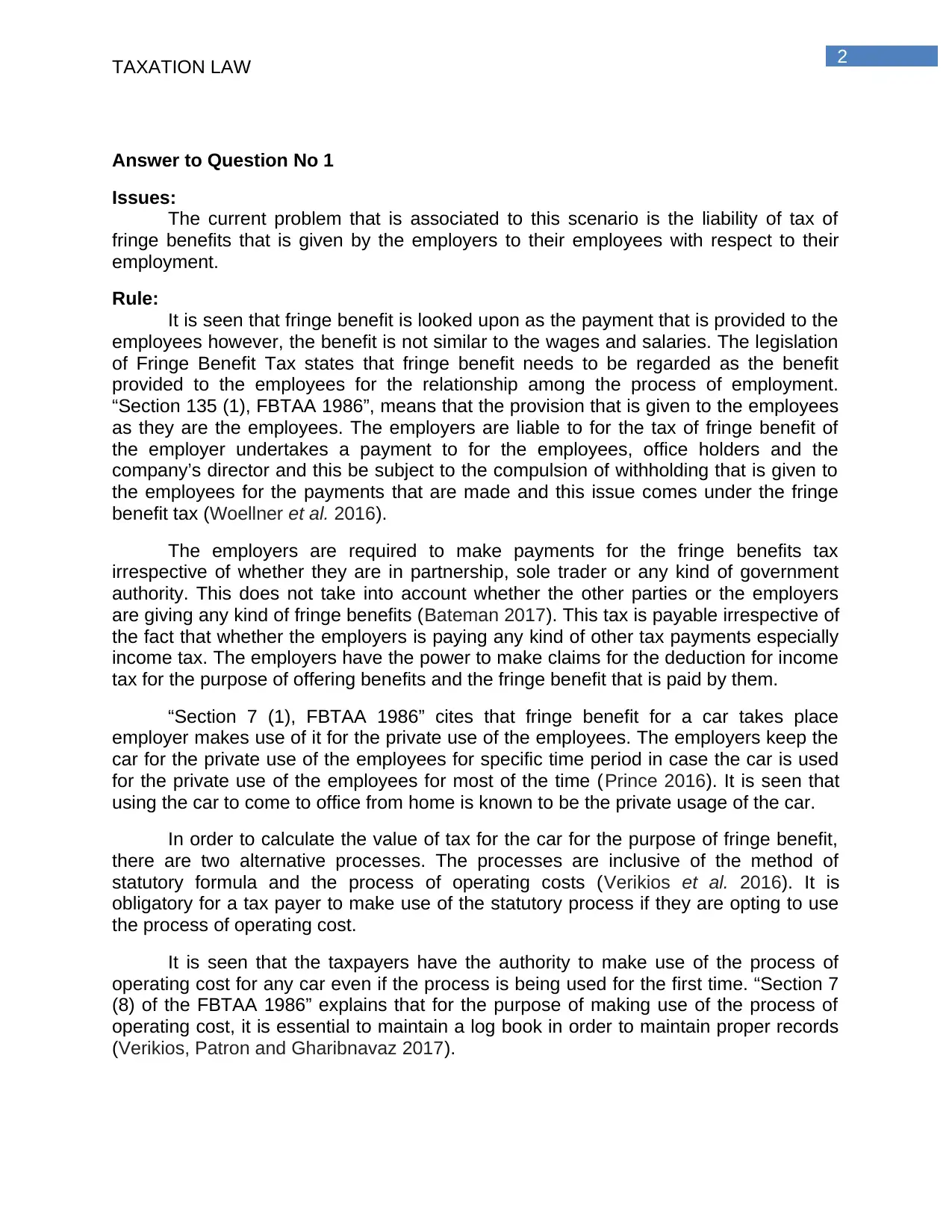
2
TAXATION LAW
Answer to Question No 1
Issues:
The current problem that is associated to this scenario is the liability of tax of
fringe benefits that is given by the employers to their employees with respect to their
employment.
Rule:
It is seen that fringe benefit is looked upon as the payment that is provided to the
employees however, the benefit is not similar to the wages and salaries. The legislation
of Fringe Benefit Tax states that fringe benefit needs to be regarded as the benefit
provided to the employees for the relationship among the process of employment.
“Section 135 (1), FBTAA 1986”, means that the provision that is given to the employees
as they are the employees. The employers are liable to for the tax of fringe benefit of
the employer undertakes a payment to for the employees, office holders and the
company’s director and this be subject to the compulsion of withholding that is given to
the employees for the payments that are made and this issue comes under the fringe
benefit tax (Woellner et al. 2016).
The employers are required to make payments for the fringe benefits tax
irrespective of whether they are in partnership, sole trader or any kind of government
authority. This does not take into account whether the other parties or the employers
are giving any kind of fringe benefits (Bateman 2017). This tax is payable irrespective of
the fact that whether the employers is paying any kind of other tax payments especially
income tax. The employers have the power to make claims for the deduction for income
tax for the purpose of offering benefits and the fringe benefit that is paid by them.
“Section 7 (1), FBTAA 1986” cites that fringe benefit for a car takes place
employer makes use of it for the private use of the employees. The employers keep the
car for the private use of the employees for specific time period in case the car is used
for the private use of the employees for most of the time (Prince 2016). It is seen that
using the car to come to office from home is known to be the private usage of the car.
In order to calculate the value of tax for the car for the purpose of fringe benefit,
there are two alternative processes. The processes are inclusive of the method of
statutory formula and the process of operating costs (Verikios et al. 2016). It is
obligatory for a tax payer to make use of the statutory process if they are opting to use
the process of operating cost.
It is seen that the taxpayers have the authority to make use of the process of
operating cost for any car even if the process is being used for the first time. “Section 7
(8) of the FBTAA 1986” explains that for the purpose of making use of the process of
operating cost, it is essential to maintain a log book in order to maintain proper records
(Verikios, Patron and Gharibnavaz 2017).
TAXATION LAW
Answer to Question No 1
Issues:
The current problem that is associated to this scenario is the liability of tax of
fringe benefits that is given by the employers to their employees with respect to their
employment.
Rule:
It is seen that fringe benefit is looked upon as the payment that is provided to the
employees however, the benefit is not similar to the wages and salaries. The legislation
of Fringe Benefit Tax states that fringe benefit needs to be regarded as the benefit
provided to the employees for the relationship among the process of employment.
“Section 135 (1), FBTAA 1986”, means that the provision that is given to the employees
as they are the employees. The employers are liable to for the tax of fringe benefit of
the employer undertakes a payment to for the employees, office holders and the
company’s director and this be subject to the compulsion of withholding that is given to
the employees for the payments that are made and this issue comes under the fringe
benefit tax (Woellner et al. 2016).
The employers are required to make payments for the fringe benefits tax
irrespective of whether they are in partnership, sole trader or any kind of government
authority. This does not take into account whether the other parties or the employers
are giving any kind of fringe benefits (Bateman 2017). This tax is payable irrespective of
the fact that whether the employers is paying any kind of other tax payments especially
income tax. The employers have the power to make claims for the deduction for income
tax for the purpose of offering benefits and the fringe benefit that is paid by them.
“Section 7 (1), FBTAA 1986” cites that fringe benefit for a car takes place
employer makes use of it for the private use of the employees. The employers keep the
car for the private use of the employees for specific time period in case the car is used
for the private use of the employees for most of the time (Prince 2016). It is seen that
using the car to come to office from home is known to be the private usage of the car.
In order to calculate the value of tax for the car for the purpose of fringe benefit,
there are two alternative processes. The processes are inclusive of the method of
statutory formula and the process of operating costs (Verikios et al. 2016). It is
obligatory for a tax payer to make use of the statutory process if they are opting to use
the process of operating cost.
It is seen that the taxpayers have the authority to make use of the process of
operating cost for any car even if the process is being used for the first time. “Section 7
(8) of the FBTAA 1986” explains that for the purpose of making use of the process of
operating cost, it is essential to maintain a log book in order to maintain proper records
(Verikios, Patron and Gharibnavaz 2017).
⊘ This is a preview!⊘
Do you want full access?
Subscribe today to unlock all pages.

Trusted by 1+ million students worldwide
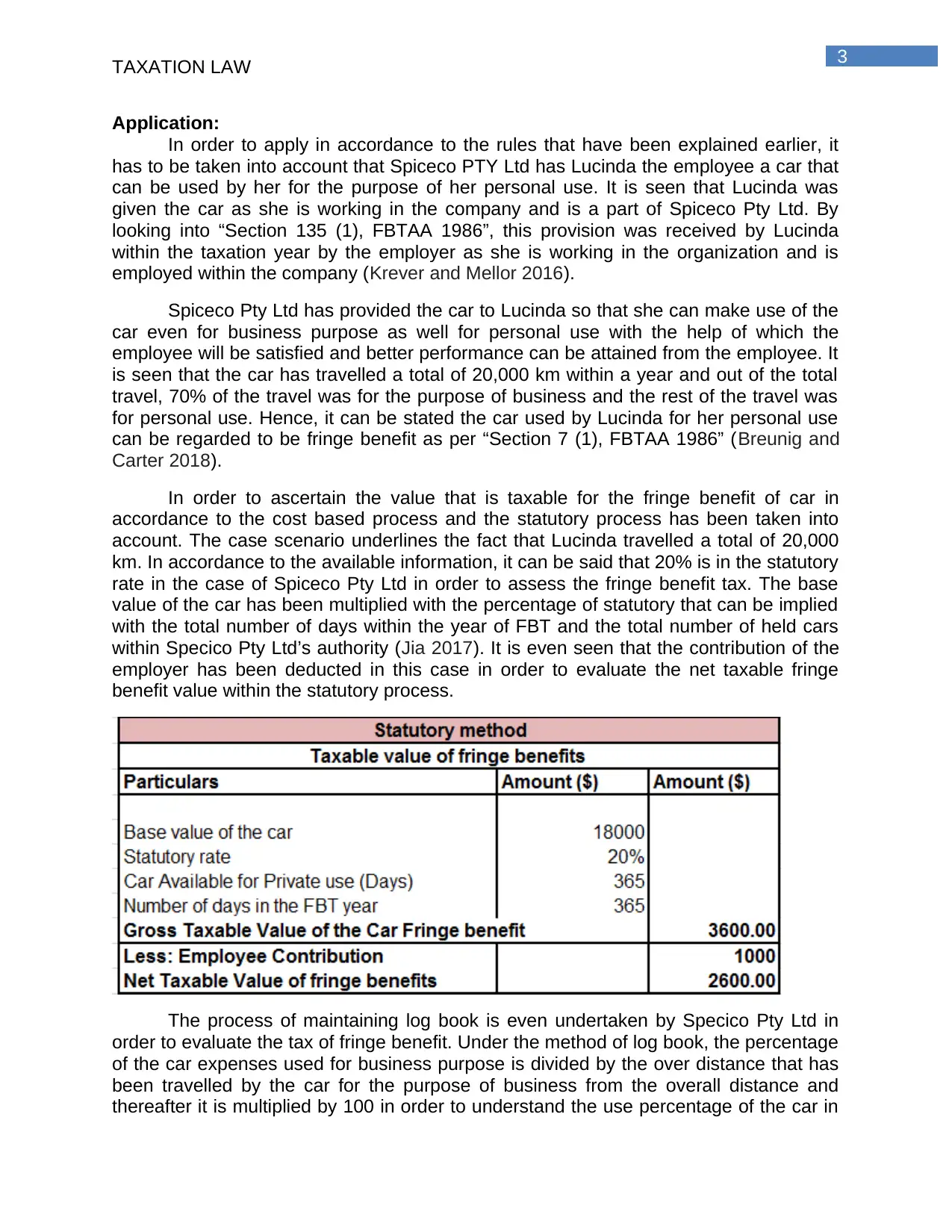
3
TAXATION LAW
Application:
In order to apply in accordance to the rules that have been explained earlier, it
has to be taken into account that Spiceco PTY Ltd has Lucinda the employee a car that
can be used by her for the purpose of her personal use. It is seen that Lucinda was
given the car as she is working in the company and is a part of Spiceco Pty Ltd. By
looking into “Section 135 (1), FBTAA 1986”, this provision was received by Lucinda
within the taxation year by the employer as she is working in the organization and is
employed within the company (Krever and Mellor 2016).
Spiceco Pty Ltd has provided the car to Lucinda so that she can make use of the
car even for business purpose as well for personal use with the help of which the
employee will be satisfied and better performance can be attained from the employee. It
is seen that the car has travelled a total of 20,000 km within a year and out of the total
travel, 70% of the travel was for the purpose of business and the rest of the travel was
for personal use. Hence, it can be stated the car used by Lucinda for her personal use
can be regarded to be fringe benefit as per “Section 7 (1), FBTAA 1986” (Breunig and
Carter 2018).
In order to ascertain the value that is taxable for the fringe benefit of car in
accordance to the cost based process and the statutory process has been taken into
account. The case scenario underlines the fact that Lucinda travelled a total of 20,000
km. In accordance to the available information, it can be said that 20% is in the statutory
rate in the case of Spiceco Pty Ltd in order to assess the fringe benefit tax. The base
value of the car has been multiplied with the percentage of statutory that can be implied
with the total number of days within the year of FBT and the total number of held cars
within Specico Pty Ltd’s authority (Jia 2017). It is even seen that the contribution of the
employer has been deducted in this case in order to evaluate the net taxable fringe
benefit value within the statutory process.
The process of maintaining log book is even undertaken by Specico Pty Ltd in
order to evaluate the tax of fringe benefit. Under the method of log book, the percentage
of the car expenses used for business purpose is divided by the over distance that has
been travelled by the car for the purpose of business from the overall distance and
thereafter it is multiplied by 100 in order to understand the use percentage of the car in
TAXATION LAW
Application:
In order to apply in accordance to the rules that have been explained earlier, it
has to be taken into account that Spiceco PTY Ltd has Lucinda the employee a car that
can be used by her for the purpose of her personal use. It is seen that Lucinda was
given the car as she is working in the company and is a part of Spiceco Pty Ltd. By
looking into “Section 135 (1), FBTAA 1986”, this provision was received by Lucinda
within the taxation year by the employer as she is working in the organization and is
employed within the company (Krever and Mellor 2016).
Spiceco Pty Ltd has provided the car to Lucinda so that she can make use of the
car even for business purpose as well for personal use with the help of which the
employee will be satisfied and better performance can be attained from the employee. It
is seen that the car has travelled a total of 20,000 km within a year and out of the total
travel, 70% of the travel was for the purpose of business and the rest of the travel was
for personal use. Hence, it can be stated the car used by Lucinda for her personal use
can be regarded to be fringe benefit as per “Section 7 (1), FBTAA 1986” (Breunig and
Carter 2018).
In order to ascertain the value that is taxable for the fringe benefit of car in
accordance to the cost based process and the statutory process has been taken into
account. The case scenario underlines the fact that Lucinda travelled a total of 20,000
km. In accordance to the available information, it can be said that 20% is in the statutory
rate in the case of Spiceco Pty Ltd in order to assess the fringe benefit tax. The base
value of the car has been multiplied with the percentage of statutory that can be implied
with the total number of days within the year of FBT and the total number of held cars
within Specico Pty Ltd’s authority (Jia 2017). It is even seen that the contribution of the
employer has been deducted in this case in order to evaluate the net taxable fringe
benefit value within the statutory process.
The process of maintaining log book is even undertaken by Specico Pty Ltd in
order to evaluate the tax of fringe benefit. Under the method of log book, the percentage
of the car expenses used for business purpose is divided by the over distance that has
been travelled by the car for the purpose of business from the overall distance and
thereafter it is multiplied by 100 in order to understand the use percentage of the car in
Paraphrase This Document
Need a fresh take? Get an instant paraphrase of this document with our AI Paraphraser
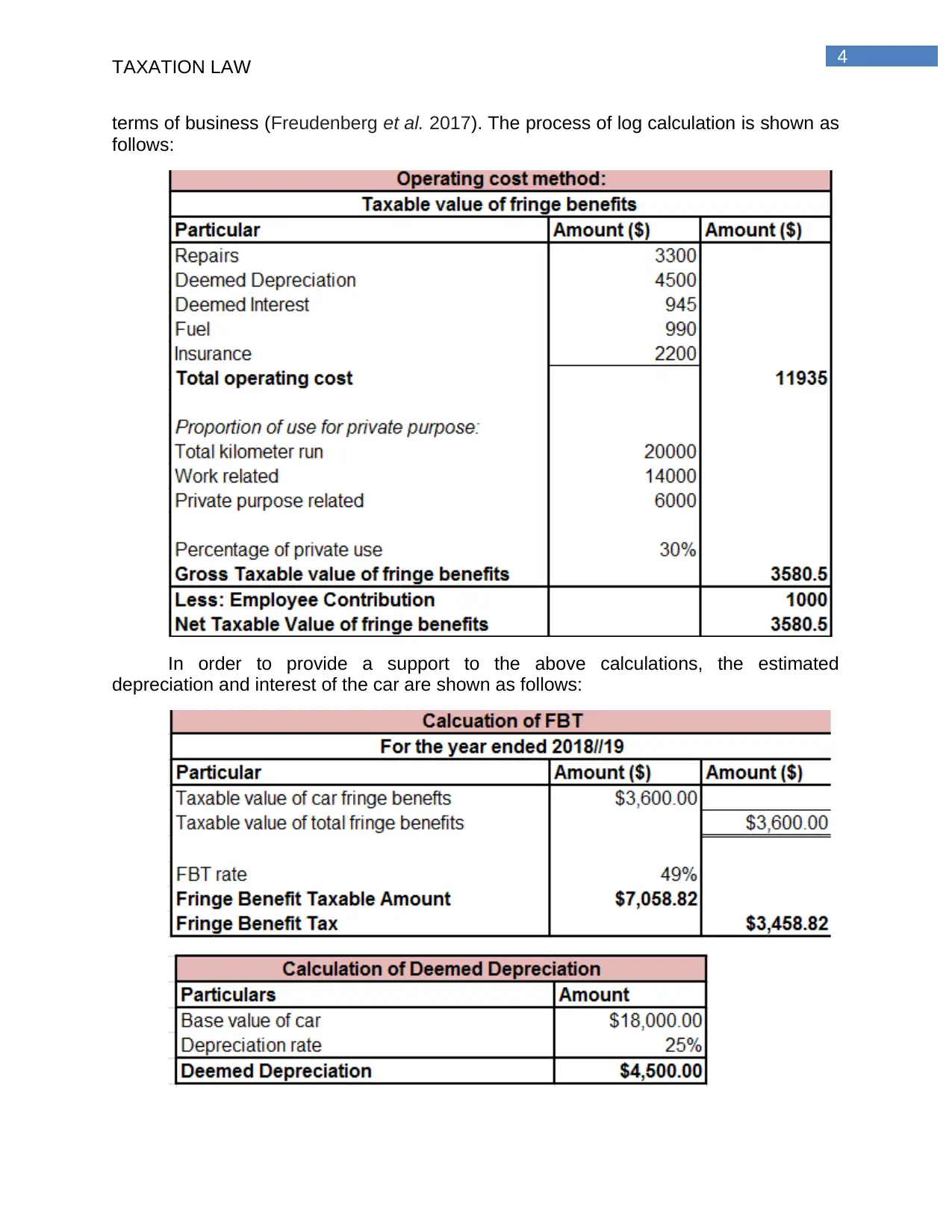
4
TAXATION LAW
terms of business (Freudenberg et al. 2017). The process of log calculation is shown as
follows:
In order to provide a support to the above calculations, the estimated
depreciation and interest of the car are shown as follows:
TAXATION LAW
terms of business (Freudenberg et al. 2017). The process of log calculation is shown as
follows:
In order to provide a support to the above calculations, the estimated
depreciation and interest of the car are shown as follows:
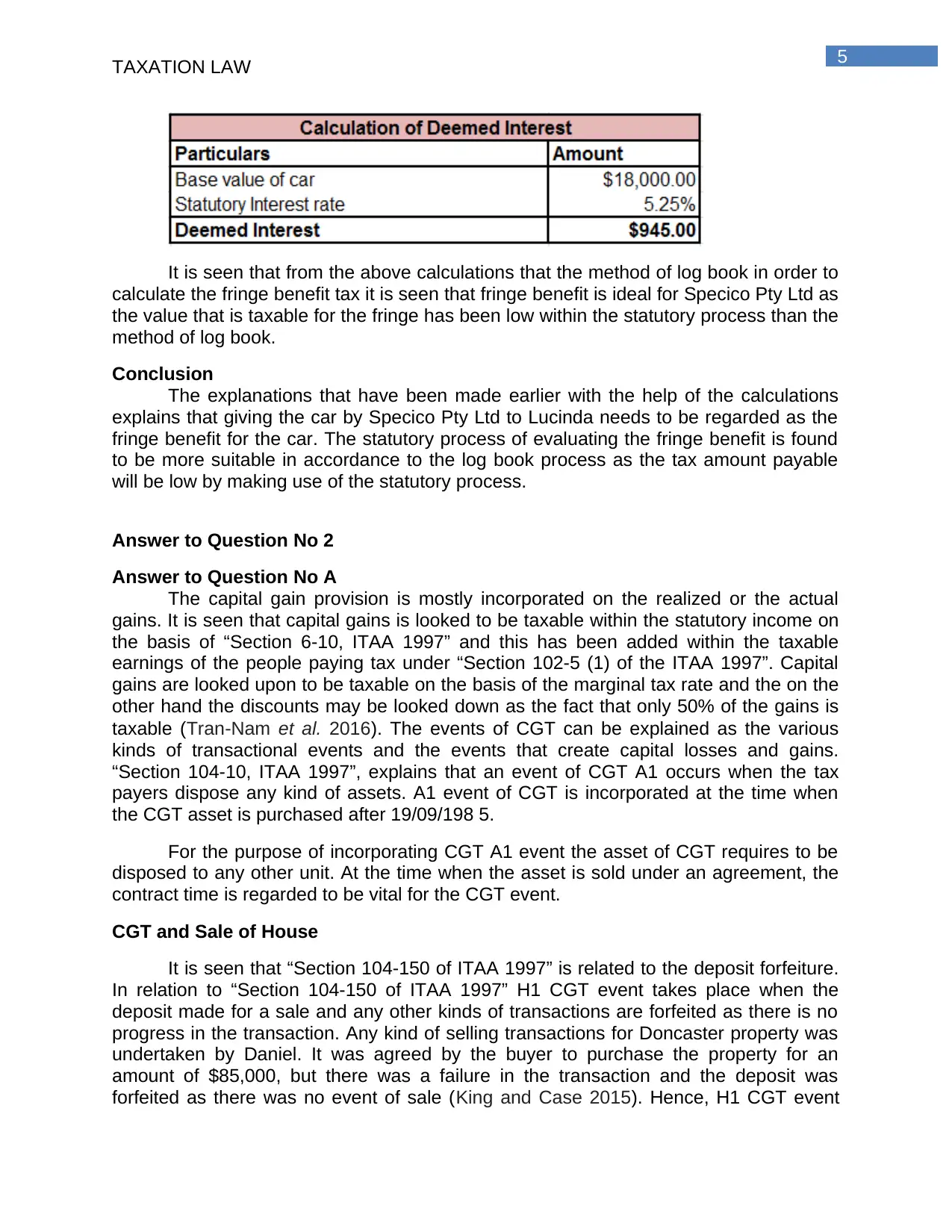
5
TAXATION LAW
It is seen that from the above calculations that the method of log book in order to
calculate the fringe benefit tax it is seen that fringe benefit is ideal for Specico Pty Ltd as
the value that is taxable for the fringe has been low within the statutory process than the
method of log book.
Conclusion
The explanations that have been made earlier with the help of the calculations
explains that giving the car by Specico Pty Ltd to Lucinda needs to be regarded as the
fringe benefit for the car. The statutory process of evaluating the fringe benefit is found
to be more suitable in accordance to the log book process as the tax amount payable
will be low by making use of the statutory process.
Answer to Question No 2
Answer to Question No A
The capital gain provision is mostly incorporated on the realized or the actual
gains. It is seen that capital gains is looked to be taxable within the statutory income on
the basis of “Section 6-10, ITAA 1997” and this has been added within the taxable
earnings of the people paying tax under “Section 102-5 (1) of the ITAA 1997”. Capital
gains are looked upon to be taxable on the basis of the marginal tax rate and the on the
other hand the discounts may be looked down as the fact that only 50% of the gains is
taxable (Tran‐Nam et al. 2016). The events of CGT can be explained as the various
kinds of transactional events and the events that create capital losses and gains.
“Section 104-10, ITAA 1997”, explains that an event of CGT A1 occurs when the tax
payers dispose any kind of assets. A1 event of CGT is incorporated at the time when
the CGT asset is purchased after 19/09/198 5.
For the purpose of incorporating CGT A1 event the asset of CGT requires to be
disposed to any other unit. At the time when the asset is sold under an agreement, the
contract time is regarded to be vital for the CGT event.
CGT and Sale of House
It is seen that “Section 104-150 of ITAA 1997” is related to the deposit forfeiture.
In relation to “Section 104-150 of ITAA 1997” H1 CGT event takes place when the
deposit made for a sale and any other kinds of transactions are forfeited as there is no
progress in the transaction. Any kind of selling transactions for Doncaster property was
undertaken by Daniel. It was agreed by the buyer to purchase the property for an
amount of $85,000, but there was a failure in the transaction and the deposit was
forfeited as there was no event of sale (King and Case 2015). Hence, H1 CGT event
TAXATION LAW
It is seen that from the above calculations that the method of log book in order to
calculate the fringe benefit tax it is seen that fringe benefit is ideal for Specico Pty Ltd as
the value that is taxable for the fringe has been low within the statutory process than the
method of log book.
Conclusion
The explanations that have been made earlier with the help of the calculations
explains that giving the car by Specico Pty Ltd to Lucinda needs to be regarded as the
fringe benefit for the car. The statutory process of evaluating the fringe benefit is found
to be more suitable in accordance to the log book process as the tax amount payable
will be low by making use of the statutory process.
Answer to Question No 2
Answer to Question No A
The capital gain provision is mostly incorporated on the realized or the actual
gains. It is seen that capital gains is looked to be taxable within the statutory income on
the basis of “Section 6-10, ITAA 1997” and this has been added within the taxable
earnings of the people paying tax under “Section 102-5 (1) of the ITAA 1997”. Capital
gains are looked upon to be taxable on the basis of the marginal tax rate and the on the
other hand the discounts may be looked down as the fact that only 50% of the gains is
taxable (Tran‐Nam et al. 2016). The events of CGT can be explained as the various
kinds of transactional events and the events that create capital losses and gains.
“Section 104-10, ITAA 1997”, explains that an event of CGT A1 occurs when the tax
payers dispose any kind of assets. A1 event of CGT is incorporated at the time when
the CGT asset is purchased after 19/09/198 5.
For the purpose of incorporating CGT A1 event the asset of CGT requires to be
disposed to any other unit. At the time when the asset is sold under an agreement, the
contract time is regarded to be vital for the CGT event.
CGT and Sale of House
It is seen that “Section 104-150 of ITAA 1997” is related to the deposit forfeiture.
In relation to “Section 104-150 of ITAA 1997” H1 CGT event takes place when the
deposit made for a sale and any other kinds of transactions are forfeited as there is no
progress in the transaction. Any kind of selling transactions for Doncaster property was
undertaken by Daniel. It was agreed by the buyer to purchase the property for an
amount of $85,000, but there was a failure in the transaction and the deposit was
forfeited as there was no event of sale (King and Case 2015). Hence, H1 CGT event
⊘ This is a preview!⊘
Do you want full access?
Subscribe today to unlock all pages.

Trusted by 1+ million students worldwide
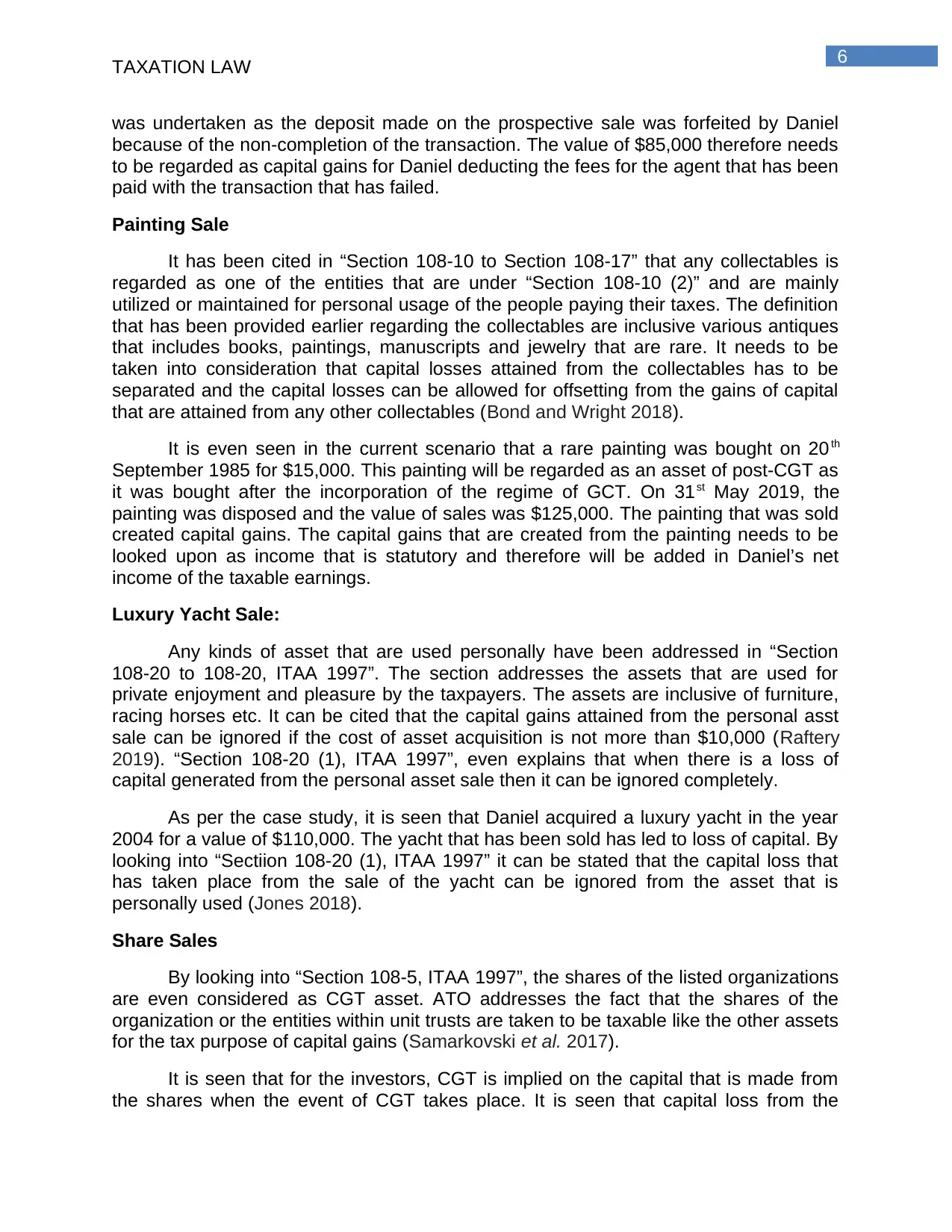
6
TAXATION LAW
was undertaken as the deposit made on the prospective sale was forfeited by Daniel
because of the non-completion of the transaction. The value of $85,000 therefore needs
to be regarded as capital gains for Daniel deducting the fees for the agent that has been
paid with the transaction that has failed.
Painting Sale
It has been cited in “Section 108-10 to Section 108-17” that any collectables is
regarded as one of the entities that are under “Section 108-10 (2)” and are mainly
utilized or maintained for personal usage of the people paying their taxes. The definition
that has been provided earlier regarding the collectables are inclusive various antiques
that includes books, paintings, manuscripts and jewelry that are rare. It needs to be
taken into consideration that capital losses attained from the collectables has to be
separated and the capital losses can be allowed for offsetting from the gains of capital
that are attained from any other collectables (Bond and Wright 2018).
It is even seen in the current scenario that a rare painting was bought on 20 th
September 1985 for $15,000. This painting will be regarded as an asset of post-CGT as
it was bought after the incorporation of the regime of GCT. On 31st May 2019, the
painting was disposed and the value of sales was $125,000. The painting that was sold
created capital gains. The capital gains that are created from the painting needs to be
looked upon as income that is statutory and therefore will be added in Daniel’s net
income of the taxable earnings.
Luxury Yacht Sale:
Any kinds of asset that are used personally have been addressed in “Section
108-20 to 108-20, ITAA 1997”. The section addresses the assets that are used for
private enjoyment and pleasure by the taxpayers. The assets are inclusive of furniture,
racing horses etc. It can be cited that the capital gains attained from the personal asst
sale can be ignored if the cost of asset acquisition is not more than $10,000 (Raftery
2019). “Section 108-20 (1), ITAA 1997”, even explains that when there is a loss of
capital generated from the personal asset sale then it can be ignored completely.
As per the case study, it is seen that Daniel acquired a luxury yacht in the year
2004 for a value of $110,000. The yacht that has been sold has led to loss of capital. By
looking into “Sectiion 108-20 (1), ITAA 1997” it can be stated that the capital loss that
has taken place from the sale of the yacht can be ignored from the asset that is
personally used (Jones 2018).
Share Sales
By looking into “Section 108-5, ITAA 1997”, the shares of the listed organizations
are even considered as CGT asset. ATO addresses the fact that the shares of the
organization or the entities within unit trusts are taken to be taxable like the other assets
for the tax purpose of capital gains (Samarkovski et al. 2017).
It is seen that for the investors, CGT is implied on the capital that is made from
the shares when the event of CGT takes place. It is seen that capital loss from the
TAXATION LAW
was undertaken as the deposit made on the prospective sale was forfeited by Daniel
because of the non-completion of the transaction. The value of $85,000 therefore needs
to be regarded as capital gains for Daniel deducting the fees for the agent that has been
paid with the transaction that has failed.
Painting Sale
It has been cited in “Section 108-10 to Section 108-17” that any collectables is
regarded as one of the entities that are under “Section 108-10 (2)” and are mainly
utilized or maintained for personal usage of the people paying their taxes. The definition
that has been provided earlier regarding the collectables are inclusive various antiques
that includes books, paintings, manuscripts and jewelry that are rare. It needs to be
taken into consideration that capital losses attained from the collectables has to be
separated and the capital losses can be allowed for offsetting from the gains of capital
that are attained from any other collectables (Bond and Wright 2018).
It is even seen in the current scenario that a rare painting was bought on 20 th
September 1985 for $15,000. This painting will be regarded as an asset of post-CGT as
it was bought after the incorporation of the regime of GCT. On 31st May 2019, the
painting was disposed and the value of sales was $125,000. The painting that was sold
created capital gains. The capital gains that are created from the painting needs to be
looked upon as income that is statutory and therefore will be added in Daniel’s net
income of the taxable earnings.
Luxury Yacht Sale:
Any kinds of asset that are used personally have been addressed in “Section
108-20 to 108-20, ITAA 1997”. The section addresses the assets that are used for
private enjoyment and pleasure by the taxpayers. The assets are inclusive of furniture,
racing horses etc. It can be cited that the capital gains attained from the personal asst
sale can be ignored if the cost of asset acquisition is not more than $10,000 (Raftery
2019). “Section 108-20 (1), ITAA 1997”, even explains that when there is a loss of
capital generated from the personal asset sale then it can be ignored completely.
As per the case study, it is seen that Daniel acquired a luxury yacht in the year
2004 for a value of $110,000. The yacht that has been sold has led to loss of capital. By
looking into “Sectiion 108-20 (1), ITAA 1997” it can be stated that the capital loss that
has taken place from the sale of the yacht can be ignored from the asset that is
personally used (Jones 2018).
Share Sales
By looking into “Section 108-5, ITAA 1997”, the shares of the listed organizations
are even considered as CGT asset. ATO addresses the fact that the shares of the
organization or the entities within unit trusts are taken to be taxable like the other assets
for the tax purpose of capital gains (Samarkovski et al. 2017).
It is seen that for the investors, CGT is implied on the capital that is made from
the shares when the event of CGT takes place. It is seen that capital loss from the
Paraphrase This Document
Need a fresh take? Get an instant paraphrase of this document with our AI Paraphraser
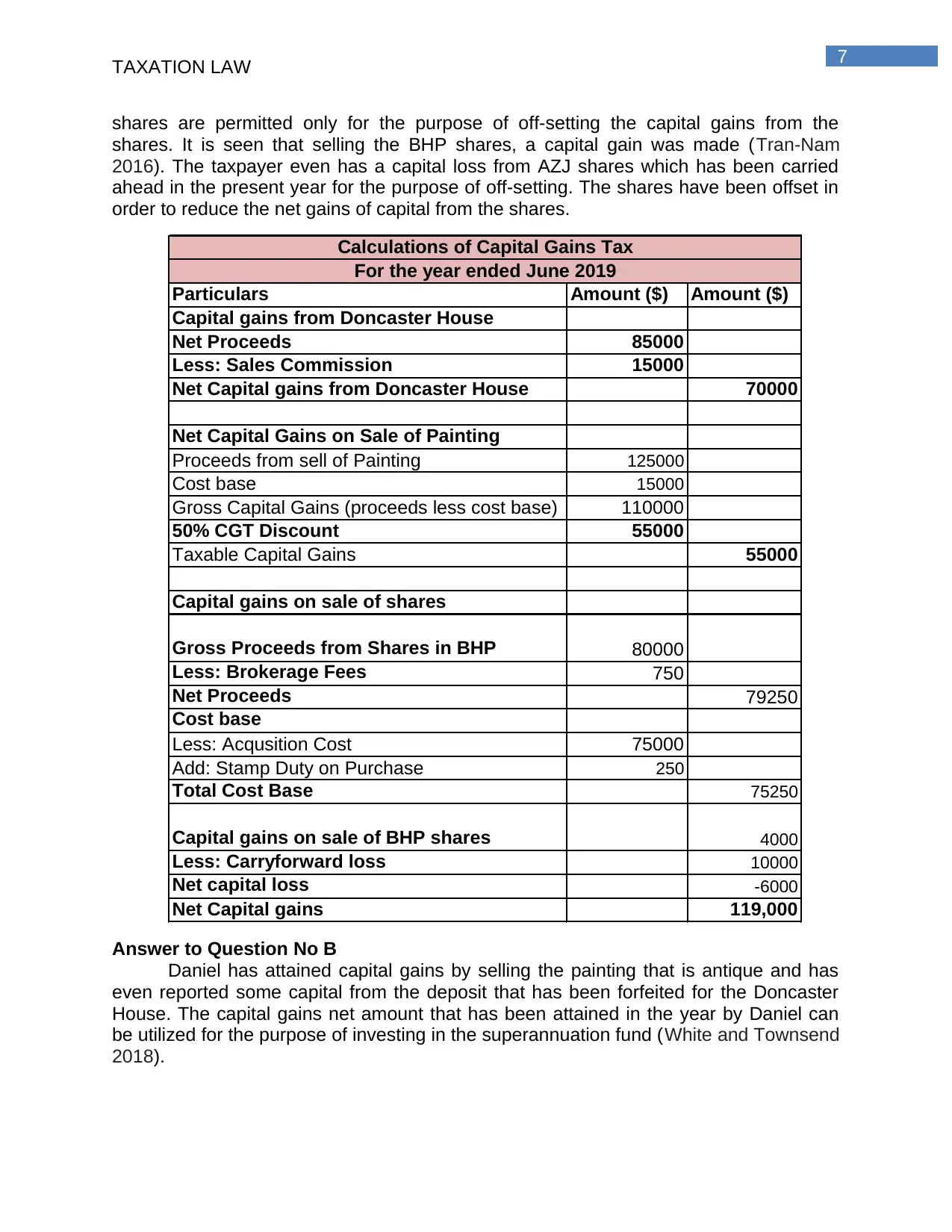
7
TAXATION LAW
shares are permitted only for the purpose of off-setting the capital gains from the
shares. It is seen that selling the BHP shares, a capital gain was made (Tran-Nam
2016). The taxpayer even has a capital loss from AZJ shares which has been carried
ahead in the present year for the purpose of off-setting. The shares have been offset in
order to reduce the net gains of capital from the shares.
Particulars Amount ($) Amount ($)
Capital gains from Doncaster House
Net Proceeds 85000
Less: Sales Commission 15000
Net Capital gains from Doncaster House 70000
Net Capital Gains on Sale of Painting
Proceeds from sell of Painting 125000
Cost base 15000
Gross Capital Gains (proceeds less cost base) 110000
50% CGT Discount 55000
Taxable Capital Gains 55000
Capital gains on sale of shares
Gross Proceeds from Shares in BHP 80000
Less: Brokerage Fees 750
Net Proceeds 79250
Cost base
Less: Acqusition Cost 75000
Add: Stamp Duty on Purchase 250
Total Cost Base 75250
Capital gains on sale of BHP shares 4000
Less: Carryforward loss 10000
Net capital loss -6000
Net Capital gains 119,000
Calculations of Capital Gains Tax
For the year ended June 2019
Answer to Question No B
Daniel has attained capital gains by selling the painting that is antique and has
even reported some capital from the deposit that has been forfeited for the Doncaster
House. The capital gains net amount that has been attained in the year by Daniel can
be utilized for the purpose of investing in the superannuation fund (White and Townsend
2018).
TAXATION LAW
shares are permitted only for the purpose of off-setting the capital gains from the
shares. It is seen that selling the BHP shares, a capital gain was made (Tran-Nam
2016). The taxpayer even has a capital loss from AZJ shares which has been carried
ahead in the present year for the purpose of off-setting. The shares have been offset in
order to reduce the net gains of capital from the shares.
Particulars Amount ($) Amount ($)
Capital gains from Doncaster House
Net Proceeds 85000
Less: Sales Commission 15000
Net Capital gains from Doncaster House 70000
Net Capital Gains on Sale of Painting
Proceeds from sell of Painting 125000
Cost base 15000
Gross Capital Gains (proceeds less cost base) 110000
50% CGT Discount 55000
Taxable Capital Gains 55000
Capital gains on sale of shares
Gross Proceeds from Shares in BHP 80000
Less: Brokerage Fees 750
Net Proceeds 79250
Cost base
Less: Acqusition Cost 75000
Add: Stamp Duty on Purchase 250
Total Cost Base 75250
Capital gains on sale of BHP shares 4000
Less: Carryforward loss 10000
Net capital loss -6000
Net Capital gains 119,000
Calculations of Capital Gains Tax
For the year ended June 2019
Answer to Question No B
Daniel has attained capital gains by selling the painting that is antique and has
even reported some capital from the deposit that has been forfeited for the Doncaster
House. The capital gains net amount that has been attained in the year by Daniel can
be utilized for the purpose of investing in the superannuation fund (White and Townsend
2018).
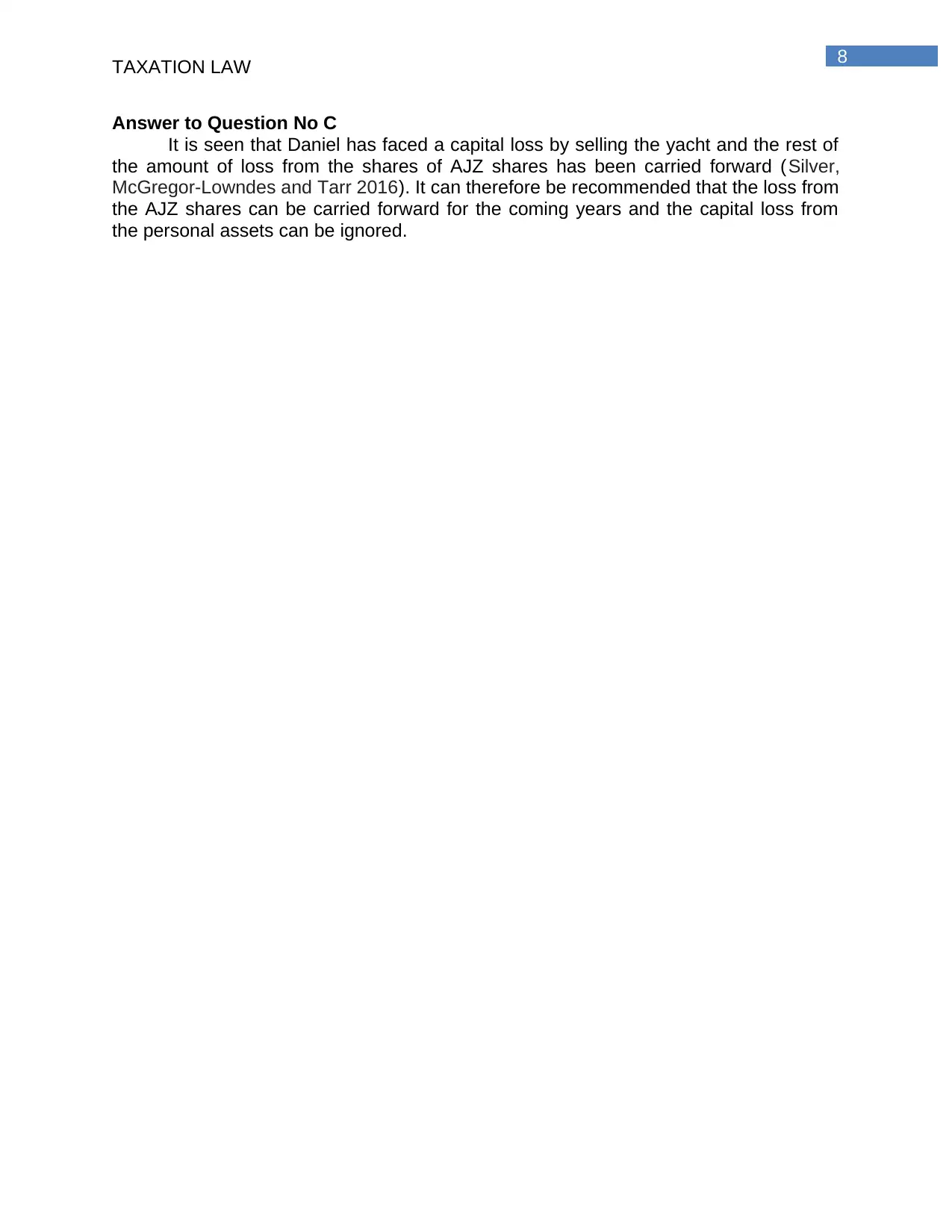
8
TAXATION LAW
Answer to Question No C
It is seen that Daniel has faced a capital loss by selling the yacht and the rest of
the amount of loss from the shares of AJZ shares has been carried forward (Silver,
McGregor-Lowndes and Tarr 2016). It can therefore be recommended that the loss from
the AJZ shares can be carried forward for the coming years and the capital loss from
the personal assets can be ignored.
TAXATION LAW
Answer to Question No C
It is seen that Daniel has faced a capital loss by selling the yacht and the rest of
the amount of loss from the shares of AJZ shares has been carried forward (Silver,
McGregor-Lowndes and Tarr 2016). It can therefore be recommended that the loss from
the AJZ shares can be carried forward for the coming years and the capital loss from
the personal assets can be ignored.
⊘ This is a preview!⊘
Do you want full access?
Subscribe today to unlock all pages.

Trusted by 1+ million students worldwide
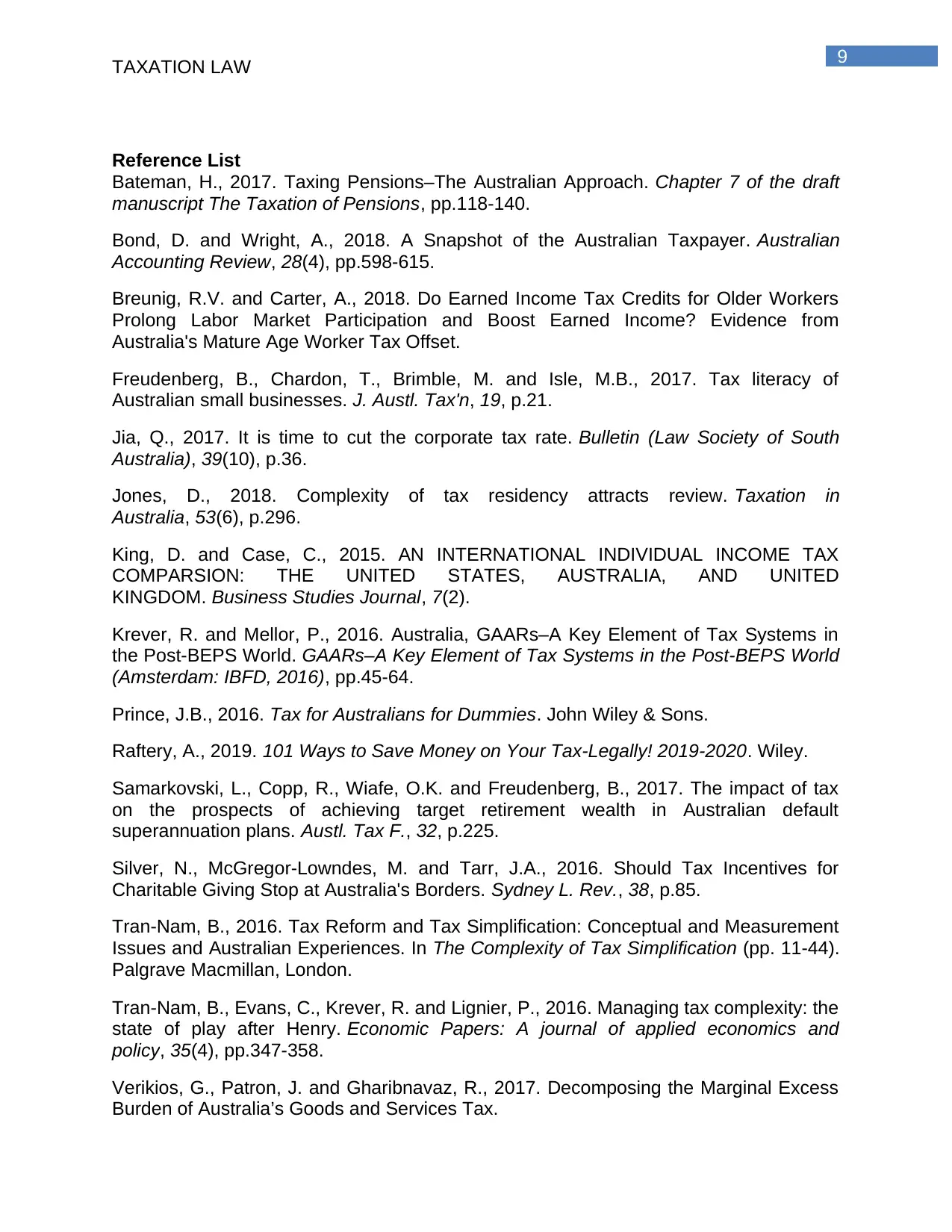
9
TAXATION LAW
Reference List
Bateman, H., 2017. Taxing Pensions–The Australian Approach. Chapter 7 of the draft
manuscript The Taxation of Pensions, pp.118-140.
Bond, D. and Wright, A., 2018. A Snapshot of the Australian Taxpayer. Australian
Accounting Review, 28(4), pp.598-615.
Breunig, R.V. and Carter, A., 2018. Do Earned Income Tax Credits for Older Workers
Prolong Labor Market Participation and Boost Earned Income? Evidence from
Australia's Mature Age Worker Tax Offset.
Freudenberg, B., Chardon, T., Brimble, M. and Isle, M.B., 2017. Tax literacy of
Australian small businesses. J. Austl. Tax'n, 19, p.21.
Jia, Q., 2017. It is time to cut the corporate tax rate. Bulletin (Law Society of South
Australia), 39(10), p.36.
Jones, D., 2018. Complexity of tax residency attracts review. Taxation in
Australia, 53(6), p.296.
King, D. and Case, C., 2015. AN INTERNATIONAL INDIVIDUAL INCOME TAX
COMPARSION: THE UNITED STATES, AUSTRALIA, AND UNITED
KINGDOM. Business Studies Journal, 7(2).
Krever, R. and Mellor, P., 2016. Australia, GAARs–A Key Element of Tax Systems in
the Post-BEPS World. GAARs–A Key Element of Tax Systems in the Post-BEPS World
(Amsterdam: IBFD, 2016), pp.45-64.
Prince, J.B., 2016. Tax for Australians for Dummies. John Wiley & Sons.
Raftery, A., 2019. 101 Ways to Save Money on Your Tax-Legally! 2019-2020. Wiley.
Samarkovski, L., Copp, R., Wiafe, O.K. and Freudenberg, B., 2017. The impact of tax
on the prospects of achieving target retirement wealth in Australian default
superannuation plans. Austl. Tax F., 32, p.225.
Silver, N., McGregor-Lowndes, M. and Tarr, J.A., 2016. Should Tax Incentives for
Charitable Giving Stop at Australia's Borders. Sydney L. Rev., 38, p.85.
Tran-Nam, B., 2016. Tax Reform and Tax Simplification: Conceptual and Measurement
Issues and Australian Experiences. In The Complexity of Tax Simplification (pp. 11-44).
Palgrave Macmillan, London.
Tran‐Nam, B., Evans, C., Krever, R. and Lignier, P., 2016. Managing tax complexity: the
state of play after Henry. Economic Papers: A journal of applied economics and
policy, 35(4), pp.347-358.
Verikios, G., Patron, J. and Gharibnavaz, R., 2017. Decomposing the Marginal Excess
Burden of Australia’s Goods and Services Tax.
TAXATION LAW
Reference List
Bateman, H., 2017. Taxing Pensions–The Australian Approach. Chapter 7 of the draft
manuscript The Taxation of Pensions, pp.118-140.
Bond, D. and Wright, A., 2018. A Snapshot of the Australian Taxpayer. Australian
Accounting Review, 28(4), pp.598-615.
Breunig, R.V. and Carter, A., 2018. Do Earned Income Tax Credits for Older Workers
Prolong Labor Market Participation and Boost Earned Income? Evidence from
Australia's Mature Age Worker Tax Offset.
Freudenberg, B., Chardon, T., Brimble, M. and Isle, M.B., 2017. Tax literacy of
Australian small businesses. J. Austl. Tax'n, 19, p.21.
Jia, Q., 2017. It is time to cut the corporate tax rate. Bulletin (Law Society of South
Australia), 39(10), p.36.
Jones, D., 2018. Complexity of tax residency attracts review. Taxation in
Australia, 53(6), p.296.
King, D. and Case, C., 2015. AN INTERNATIONAL INDIVIDUAL INCOME TAX
COMPARSION: THE UNITED STATES, AUSTRALIA, AND UNITED
KINGDOM. Business Studies Journal, 7(2).
Krever, R. and Mellor, P., 2016. Australia, GAARs–A Key Element of Tax Systems in
the Post-BEPS World. GAARs–A Key Element of Tax Systems in the Post-BEPS World
(Amsterdam: IBFD, 2016), pp.45-64.
Prince, J.B., 2016. Tax for Australians for Dummies. John Wiley & Sons.
Raftery, A., 2019. 101 Ways to Save Money on Your Tax-Legally! 2019-2020. Wiley.
Samarkovski, L., Copp, R., Wiafe, O.K. and Freudenberg, B., 2017. The impact of tax
on the prospects of achieving target retirement wealth in Australian default
superannuation plans. Austl. Tax F., 32, p.225.
Silver, N., McGregor-Lowndes, M. and Tarr, J.A., 2016. Should Tax Incentives for
Charitable Giving Stop at Australia's Borders. Sydney L. Rev., 38, p.85.
Tran-Nam, B., 2016. Tax Reform and Tax Simplification: Conceptual and Measurement
Issues and Australian Experiences. In The Complexity of Tax Simplification (pp. 11-44).
Palgrave Macmillan, London.
Tran‐Nam, B., Evans, C., Krever, R. and Lignier, P., 2016. Managing tax complexity: the
state of play after Henry. Economic Papers: A journal of applied economics and
policy, 35(4), pp.347-358.
Verikios, G., Patron, J. and Gharibnavaz, R., 2017. Decomposing the Marginal Excess
Burden of Australia’s Goods and Services Tax.
Paraphrase This Document
Need a fresh take? Get an instant paraphrase of this document with our AI Paraphraser
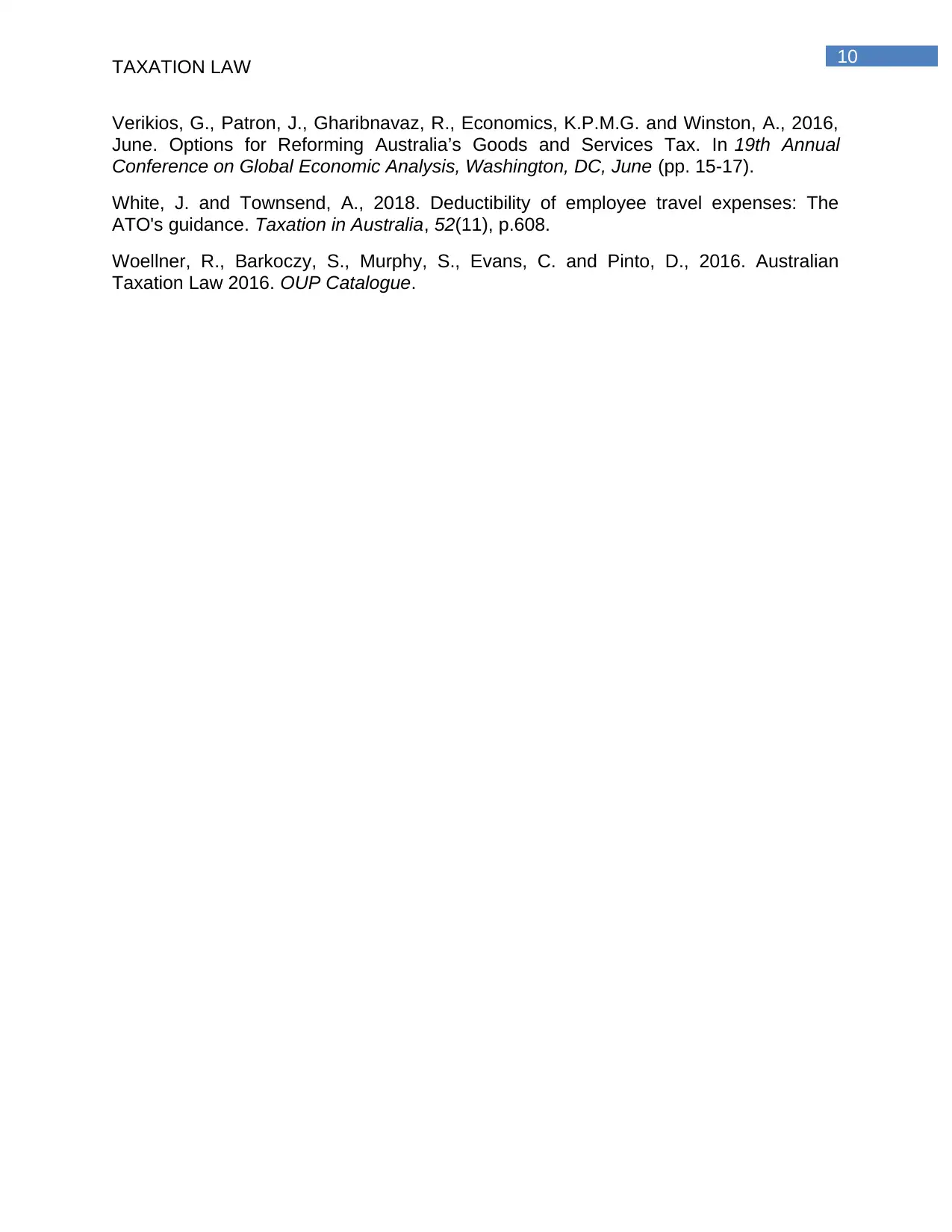
10
TAXATION LAW
Verikios, G., Patron, J., Gharibnavaz, R., Economics, K.P.M.G. and Winston, A., 2016,
June. Options for Reforming Australia’s Goods and Services Tax. In 19th Annual
Conference on Global Economic Analysis, Washington, DC, June (pp. 15-17).
White, J. and Townsend, A., 2018. Deductibility of employee travel expenses: The
ATO's guidance. Taxation in Australia, 52(11), p.608.
Woellner, R., Barkoczy, S., Murphy, S., Evans, C. and Pinto, D., 2016. Australian
Taxation Law 2016. OUP Catalogue.
TAXATION LAW
Verikios, G., Patron, J., Gharibnavaz, R., Economics, K.P.M.G. and Winston, A., 2016,
June. Options for Reforming Australia’s Goods and Services Tax. In 19th Annual
Conference on Global Economic Analysis, Washington, DC, June (pp. 15-17).
White, J. and Townsend, A., 2018. Deductibility of employee travel expenses: The
ATO's guidance. Taxation in Australia, 52(11), p.608.
Woellner, R., Barkoczy, S., Murphy, S., Evans, C. and Pinto, D., 2016. Australian
Taxation Law 2016. OUP Catalogue.
1 out of 11
Related Documents
Your All-in-One AI-Powered Toolkit for Academic Success.
+13062052269
info@desklib.com
Available 24*7 on WhatsApp / Email
![[object Object]](/_next/static/media/star-bottom.7253800d.svg)
Unlock your academic potential
Copyright © 2020–2025 A2Z Services. All Rights Reserved. Developed and managed by ZUCOL.





